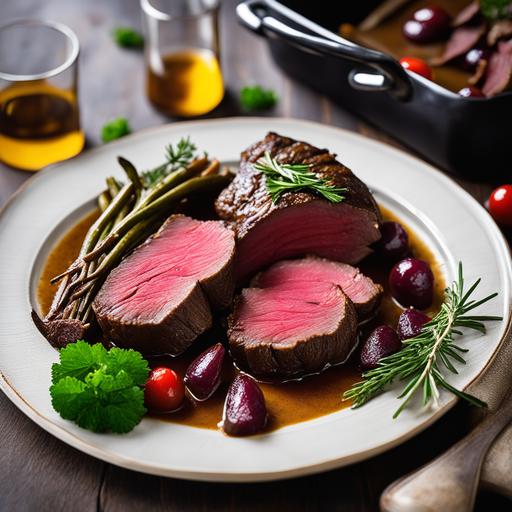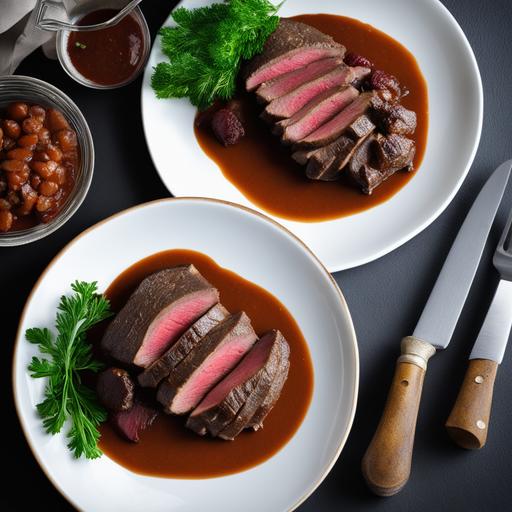
Venison Oven Recipe: A Culinary Delight For Meat Enthusiasts
Are you a meat lover seeking a new and exciting culinary adventure? Look no further than venison, a lean and flavorful meat that will tantalize your taste buds like never before. In this comprehensive guide, we will delve into the wonderful world of venison oven recipes, exploring the food science behind this delicious meat, culinary details, selection, cleaning, preparation, essential tips, versatile variations, doneness checks, and ultimately, a mouthwatering recipe that will leave you craving for more. So, brace yourself for an informative and indulgent journey!
The Science of Venison: Understanding the Meat’s Composition and Flavor
Venison, derived from deer, is a unique meat that carries distinct qualities, setting it apart from traditional meats like beef and pork. Understanding the science behind this lean delicacy will help you elevate your culinary skills and make the most of this exceptional ingredient.
1. Composition
Venison is remarkably low in fat and calories, making it an excellent choice for health-conscious individuals. Its leanness is primarily due to the deer’s active lifestyle and natural diet. With less marbling, venison possesses a rich, distinct flavor that pairs beautifully with various seasonings and spices.
2. Flavor Profile
The flavor of venison is often described as earthy, slightly gamey, and deeply savory. The meat carries a robust taste that intensifies when properly prepared, making it an ideal choice for those who prefer bold and complex flavors.
Selecting and Cleaning Venison: Ensuring Quality and Safety
Choosing top-quality venison and properly preparing it is crucial to ensure a delightful dining experience. Whether you opt for farm-raised or wild venison, these steps will help you make informed decisions and attain optimal taste and safety.
1. Selection
When purchasing venison, consider sourcing it from reputable suppliers or local farmers’ markets. Look for cuts that are deep red in color, with a fine grain and little to no bruising. Ensure that the meat has been handled and stored properly, maintaining its freshness and integrity.
2. Cleaning
Before cooking venison, it’s essential to clean it thoroughly to remove any bone fragments, sinew, or excess fat. Begin by patting the meat dry with paper towels. If there are any visible impurities, carefully trim them away using a sharp knife. However, avoid over-trimming, as fat imparts flavor and moisture to the meat during the cooking process.
Preparing Venison: The Art of Transforming Quality Meat into Culinary Masterpieces

Preparing venison requires careful attention to detail to unlock its full gastronomic potential. Follow these steps to ensure the tenderness, succulence, and flavor of this extraordinary meat shine through in every bite.
1. Tenderizing
Venison, although inherently tender, can occasionally benefit from tenderizing techniques. The gentle art of pounding the meat with a mallet or using a meat tenderizer will not only break down any tough fibers but also allow marinades and seasonings to penetrate the meat more effectively.
2. Marinades and Seasonings
Marinades play a vital role in enhancing the flavor and texture of venison. Opt for acidic marinades containing ingredients like red wine, balsamic vinegar, or citrus juices. These natural acids work to tenderize the meat while infusing it with a burst of complementary flavors. Additionally, when seasoning your venison, experiment with a range of herbs, spices, and aromatics that complement its earthy profile.
3. Cooking Temperatures
Cooking venison requires diligence to prevent overcooking or drying out the meat. Preheat your oven to an appropriate temperature, usually ranging between 325°F (160°C) and 375°F (190°C), depending on the recipe. This ensures the interior cooks evenly while keeping the outer segments deliciously caramelized and full of flavor.
Essential Tips for Venison Oven Preparation

To ensure a successful and enjoyable venison cooking experience, here are some essential tips to keep in mind when using the oven as your cooking method:
1. Temperature Control
Invest in an oven thermometer to accurately monitor the internal temperature. Different cuts of venison require different cooking times and temperatures, hence controlling the oven’s heat is crucial to achieving the desired level of doneness and avoiding culinary catastrophes.
2. Resting Time
After removing your venison from the oven, allow it to rest for a few minutes before slicing or serving. This invaluable resting period allows the meat’s juices to redistribute, resulting in a more tender and flavorful end product.
3. Basting and Glazing
To enhance the succulence of your venison, consider basting it occasionally during the cooking process. This involves spooning the cooking juices or relevant marinades over the meat to retain moisture and infuse added flavor.
4. Thinly Slicing
When serving venison, it is recommended to slice it thinly against the grain. This cutting technique maximizes tenderness and preserves the integrity of the meat’s natural texture.
Variations and Doneness Checks: Tailoring Venison to Your Palate
Venison offers limitless possibilities for customization and personalization. Incorporating variations into your culinary repertoire will keep your guests and taste buds entertained. Before diving into our delectable venison oven recipe, we must explore different levels of doneness and considerations for checking for it.
1. Doneness Levels
Cooking venison to perfection requires an understanding of the various degrees of doneness. These levels range from rare to well-done. When aiming for a specific doneness, use a meat thermometer to verify the internal temperature and ensure ideal results.
-
Rare: 120°F (49°C) to 125°F (52°C)
-
Medium Rare: 130°F (54°C) to 135°F (57°C)
-
Medium: 140°F (60°C) to 145°F (63°C)
-
Medium Well: 150°F (66°C) to 155°F (68°C)
-
Well Done: 160°F (71°C) and above
2. Doneness Checks
Apart from utilizing a meat thermometer, experienced chefs also employ alternative doneness checks. These include touch or feel tests, where the firmness of the meat’s center is compared to different parts of the hand to estimate its level of doneness.
With the foundational knowledge of venison science, selection, cleaning, preparation, essential tips, and doneness considerations, it’s time to indulge in an irresistible venison oven recipe!
Venison Oven Recipe: Herb-Crusted Rack of Venison
Ingredients:
-
1 rack of venison, frenched
-
Olive oil
-
1 tablespoon Dijon mustard
-
2 cloves of garlic, minced
-
1 tablespoon fresh rosemary, finely chopped
-
1 tablespoon fresh thyme, finely chopped
-
Salt and pepper to taste
Instructions:
-
Preheat your oven to 375°F (190°C).
-
In a small mixing bowl, combine minced garlic, chopped rosemary, chopped thyme, olive oil, Dijon mustard, salt, and pepper.
-
Generously coat the venison rack with the mixture, ensuring all sides are thoroughly covered.
-
Heat a cast-iron skillet over medium-high heat until hot.
-
Sear the rack of venison on all sides for approximately 2 minutes per side, or until nicely browned.
-
Transfer the skillet to the preheated oven, ensuring the rack is bone-side down.
-
Roast for about 15-18 minutes or until the internal temperature reaches your desired level of doneness. Remember to refer to the doneness chart for guidance.
-
Remove the rack of venison from the oven and let it rest for 10 minutes before slicing.
-
Slice the rack between the bones into individual servings and serve immediately.
Conclusion: Unleash Your Inner Chef with Venison Oven Delights
Congratulations! You’ve embarked on a culinary journey to discover the wonders of venison oven recipes. From understanding the science behind this lean meat to selecting and cleaning, preparing, and cooking it to perfection, you are now equipped to master the art of indulging in delicious venison dishes.
Remember, always source top-quality venison, properly clean and prepare it, experiment with flavors and seasonings, and pay attention to doneness levels for an exceptional dining experience. Whether you choose the herb-crusted rack of venison or explore countless other recipes, you are sure to captivate your taste buds and impress your guests with this unique and flavorful meat.
So, grab your apron, preheat that oven, and let venison take center stage in your culinary repertoire. Happy cooking and bon appétit!
Sources
FAQS On Venison Oven Recipe
What Temperature Should I Set My Oven To When Cooking Venison?
The recommended temperature for cooking venison in the oven is 350°F.
How Long Should I Cook Venison In The Oven?
The cooking time for venison in the oven will vary depending on the cut and size of the meat. As a general rule, plan for about 18-20 minutes of cooking time per pound.
Should I Marinate Venison Before Cooking?
Marinating venison can help tenderize the meat and add flavor. You can marinate for as little as 30 minutes or up to 24 hours, depending on your preference.
Do I Need To Cover The Venison When Cooking In The Oven?
It is recommended to cover the venison with aluminum foil or a lid while cooking in the oven to prevent it from drying out.
Can I Use A Meat Thermometer To Check The Doneness Of The Venison?
Yes, a meat thermometer is the most accurate way to check the internal temperature of the venison. The recommended temperature for medium-rare is 135°F, medium is 145°F, and well-done is 160°F.


